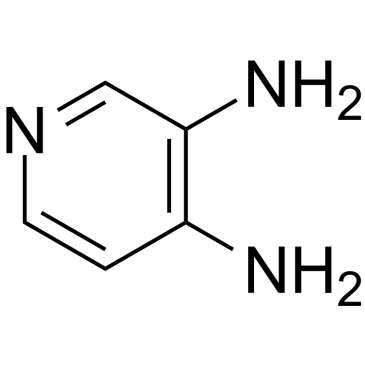
Amifampridine
CAS No. 54-96-6
Amifampridine( 3,4-Diaminopyridine )
Catalog No. M18788 CAS No. 54-96-6
Amifampridine works by blocking potassium channel efflux in nerve terminals so that action potential duration is increased. Ca2+ channels can then be open for a longer time and allow greater acetylcholine release to stimulate muscle at the end plate.
Purity : >98% (HPLC)
 COA
COA
 Datasheet
Datasheet
 HNMR
HNMR
 HPLC
HPLC
 MSDS
MSDS
 Handing Instructions
Handing Instructions
| Size | Price / USD | Stock | Quantity |
| 50MG | 32 | In Stock |


|
| 100MG | 45 | In Stock |


|
| 200MG | Get Quote | In Stock |


|
| 500MG | Get Quote | In Stock |


|
| 1G | Get Quote | In Stock |


|
Biological Information
-
Product NameAmifampridine
-
NoteResearch use only, not for human use.
-
Brief DescriptionAmifampridine works by blocking potassium channel efflux in nerve terminals so that action potential duration is increased. Ca2+ channels can then be open for a longer time and allow greater acetylcholine release to stimulate muscle at the end plate.
-
DescriptionAmifampridine is predominantly in the treatment of a number of rare muscle diseases. Amifampridine works by blocking potassium channel efflux in nerve terminals so that action potential duration is increased. Ca2+ channels can then be open for a longer time and allow greater acetylcholine release to stimulate muscle at the end plate.(In Vitro):Amifampridine (1.5 μM) significantly reduces Kv3.3 and Kv3.4 currents by about 10% in HEK293T cells, has no effect on Cav2.1 or Cav1.2 current.Amifampridine (0-100 μM) increases the duration of the presynaptic AP (action potential) waveform at mammalian and frog NMJs in a dose-dependent manner.(In Vivo):Amifampridine (Oral gavage; 10 mg/kg; once) can antagonize muscle paralysis following BoNT/A intoxication.Amifampridine (2.5 mg/kg (IV); 10 mg/kg (PO); once) shows 1 hour plasma half-life and about 57% bioavailability (F) in mice.Amifampridine has a short plasma half-life and can induce seizures when present at high concentrations, following penetration of the blood-brain barrier.
-
In VitroAmifampridine (1.5 μM) significantly reduces Kv3.3 and Kv3.4 currents by about 10% in HEK293T cells, has no effect on Cav2.1 or Cav1.2 current.Amifampridine (0-100 μM) increases the duration of the presynaptic AP (action potential) waveform at mammalian and frog NMJs in a dose-dependent manner.
-
In VivoAmifampridine (Oral gavage; 10 mg/kg; once) can antagonize muscle paralysis following BoNT/A intoxication.Amifampridine (2.5 mg/kg (IV); 10 mg/kg (PO); once) shows 1 hour plasma half-life and about 57% bioavailability (F) in mice.Amifampridine has a short plasma half-life and can induce seizures when present at high concentrations, following penetration of the blood-brain barrier. Animal Model:CD-1 mouse (female,25 g, 6 weeks old)Dosage:10 mg/kg Administration:Oral gavage, once, after BoNT/A administration (IP)Result:Revealed that neither LEMs alone (182 ± 43 min) nor the maximum safe orally deliverable dose of 3,4-DAP alone (225 ± 24 min) could significantly increase the time to death following toxin administration (216 ± 29 min). However, when the 10/50/40 3,4-DAP/LEM/shellac formulation was administered at 25 mg/kg the time to death was 302 ± 26 min - a 40% increase as compared to toxin alone.Animal Model:CD-1 mouse (30-35 g, 8 weeks old)Dosage:2.5 mg/kg (IV); 10 mg/kg (PO)Administration:IV, orally, once (Pharmacokinetic Analysis)Result:Pharmacokinetic Parameters of Amifampridine in CD-1 mouse.
-
Synonyms3,4-Diaminopyridine
-
PathwayOthers
-
TargetOther Targets
-
RecptorOthers
-
Research AreaOthers-Field
-
Indication——
Chemical Information
-
CAS Number54-96-6
-
Formula Weight109.13
-
Molecular FormulaC5H7N3
-
Purity>98% (HPLC)
-
SolubilityDMSO : ≥ 38 mg/mL; 348.21 mM
-
SMILESNc1ccncc1N
-
Chemical Name——
Shipping & Storage Information
-
Storage(-20℃)
-
ShippingWith Ice Pack
-
Stability≥ 2 years
Reference
molnova catalog



related products
-
Abagovomab
Abagovomab (Anti-Human CA-125 Recombinant Antibody) is a murine monoclonal antibody produced by hybridoma cells in mice that targets the tumor-associated antigen CA-125 and is used to study ovarian cancer.
-
Sedanolide
Sedanolide is a natural phthalide first isolated from seed oil of the Umbelliferae family including celery.
-
Imipramine (hydrochl...
Imipramine (hydrochloride) is a first generation tricyclic antidepressant that acts primarily as an inhibitor of serotonin and norepinephrine transporters (Kds = 1.4 and 37 nM respectively).



 Cart
Cart
 sales@molnova.com
sales@molnova.com


